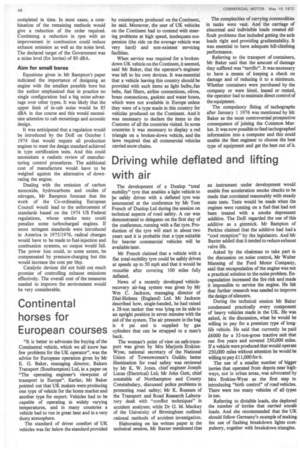Continental horses for European courses
Page 50

If you've noticed an error in this article please click here to report it so we can fix it.
"It is better to advocate the buying of the Continental vehicle, which we all know has few problems for the UK operator", was the advice for European operation given by Mr E. G. Baker, managing director, Bakers Transport (Southampton) Ltd, in a paper on "The operating engineer's viewpoint of transport in Europe". Earlier, Mr Baker pointed out that UK makers were producing one type of vehicle for the home market and another type for export. Vehicles had to be capable of operating in widely varying temperatures, and in many countries a vehicle had to run in great heat and in a very dusty atmosphere.
The standard of driver comfort of UK vehicles was far below the standard provided by counterparts produced on the Continent, he said. Moreover, the user of UK vehicles on the Continent had to contend with steering problems at high speed, inadequate suspension (the ride on the average vehicle was very hard) and non-existent servicing facilities.
When service was required for a brokendown UK vehicle on the Continent, it seemed, said Mr Baker, that the operator's engineer was left to his own devices. It was essential that a vehicle leaving this country should be provided with such items as light bulbs, fan belts, fuel filters, airline connections, olives, brass connections, gaskets and water hoses, which were not available in Europe unless they were of a type made in this country for vehicles produced on the Continent. And it was necessary to declare the items to the Customs of all the countries visited. In some countries it was necessary to display a red triangle on a broken-down vehicle, and the laws required that all commercial vehicles carried snow chains. The complexities of carrying commodities in tanks were vast. And the carriage of abnormal and indivisible loads created difficult problems that included getting the axle loads right and providing gradientability. It was essential to have adequate hill-climbing performance.
Referring to the transport of containers, Mr Baker said that the amount of damage they suffered was "terrific". It was necessary to have a means of keeping a check on damage and of reducing it to a minimum. Whether containers were purchased by the company or were hired, leased or rented, the operator had to maintain direct control of the equipment.
The compulsory fitting of tachographs after January 1 1976 was mentioned by Mr Baker as the most controversial prospective consequence of joining the Common Market. It was now possible to feed tachographecl information into a computer and this could enable the fleet engineer to choose the best type of equipment and get the best out of it.




























































































































